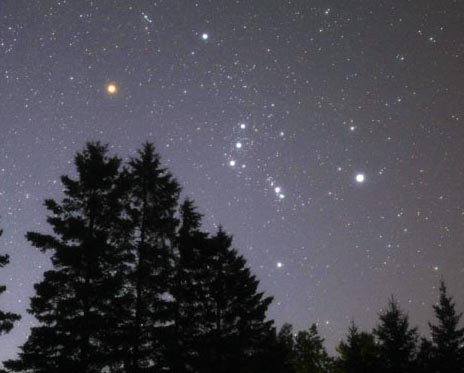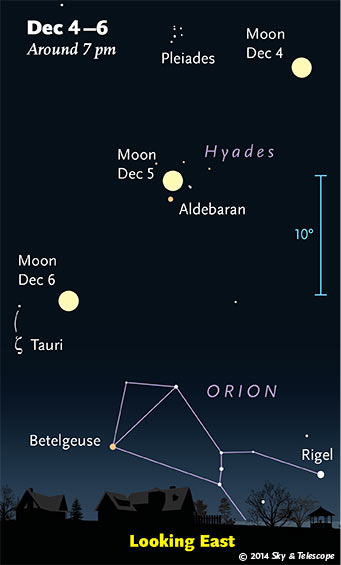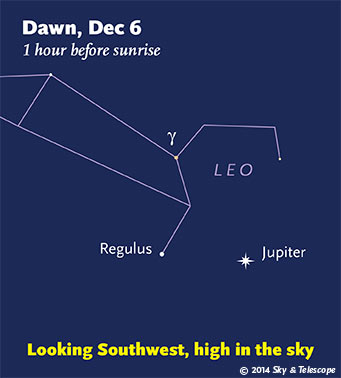Some daily sky sights among the ever-changing Moon, planets, and stars.

Friday, November 28
First-quarter Moon (exactly first-quarter at 5:06 a.m. Saturday morning EST). Look this evening for Fomalhaut far to the Moon's lower left, and for Enif, the nose of Pegasus, almost as far to the Moon's upper right.
Saturday, November 29
The Moon stands high in the south soon after nightfall, with the western side of the Great Square of Pegasus pointing down at it from above.
Sunday, November 30
It's the last day of November — so by 7 or 8 p.m. (depending on where you live) Orion is already clearing the eastern horizon, and by 9 or 10 p.m. it's striding well on its way upward in the southeast, as shown here.
By 10 or 11 p.m., the dim Little Dipper hangs straight down from Polaris.
Monday, December 1
Just as twilight fades away and night begins, look southwest for Mars. Above it by 10° — about a fist-width at arm's length — are Alpha and Beta Capricorni, both 3rd magnitude. Alpha, pale yellow-orange, is the one on the upper right. With sharp or well-corrected vision you can just make out that it's double. Binoculars split it very plainly and show other stars making an interesting asterism with it.
Binoculars also resolve more difficult Beta, whose secondary star is both fainter and closer in (to the bright component's lower right).
Tuesday, December 2
The Moon shines in the southeast soon after dark. Look below it, by a bit less than a fist at arm's length, for Alpha Piscium, the 3.8-magnitude star in Pisces that traditionally marks where the cords from the two fishes' tails are tied in a knot. Its name, Alrescha, is from the Arabic for "the rope," based on the ancient Greek description of the constellation.
Also this evening: Telescope users can watch the Moon's thin, invisible dark limb occult (black out) the 4.3-magnitude star Omicron Piscium as seen from the eastern half of North America except the southeast. Map and timetables.
Wednesday, December 3
Look about a fist and a half above the Moon this evening for the brightest stars of little Aries. Farther left of the Moon are the Pleiades, and much farther left sparkles bright Capella.

Thursday, December 4
Today brings the year's earliest end of evening twilight (if you're near 40° north latitude): at 6:11 p.m. if you live right on your time zone's standard meridian at that latitude. But the difference from day to day right now is very slight.
Friday, December 5
The Moon is essentially full both this evening and Saturday evening (exactly full at 7:27 a.m. Saturday morning EST.) On Friday evening in the Americas, the Moon shines less than about 2° from Aldebaran.
Saturday, December 6
By mid-evening the Moon shines high in the east. It's in a starry part of the sky. Aldebaran is now to its upper right. To the Moon's lower right is Aldebaran-colored Betelgeuse. Much farther lower left of the Moon are Castor and Pollux. High to the Moon's upper left shines brighter Capella.
________________________________
Want to become a better astronomer? Learn your way around the constellations. They're the key to locating everything fainter and deeper to hunt with binoculars or a telescope.
This is an outdoor nature hobby; for an easy-to-use constellation guide covering the whole evening sky, use the big monthly map in the center of each issue of Sky & Telescope, the essential guide to astronomy. Or download our free Getting Started in Astronomy booklet (which only has bimonthly maps).

Once you get a telescope, to put it to good use you'll need a detailed, large-scale sky atlas (set of charts). The standards are the little Pocket Sky Atlas, which shows stars to magnitude 7.6; the larger and deeper Sky Atlas 2000.0 (stars to magnitude 8.5); and once you know your way around, the even larger Uranometria 2000.0 (stars to magnitude 9.75). And read how to use sky charts with a telescope.
You'll also want a good deep-sky guidebook, such as Sue French's Deep-Sky Wonders collection (which includes its own charts), Sky Atlas 2000.0 Companion by Strong and Sinnott, the bigger Night Sky Observer's Guide by Kepple and Sanner, or the beloved if dated Burnham's Celestial Handbook.
Can a computerized telescope replace charts? Not for beginners, I don't think, and not on mounts and tripods that are less than top-quality mechanically (able to point with better than 0.2° repeatability, which means fairly heavy and expensive). As Terence Dickinson and Alan Dyer say in their Backyard Astronomer's Guide, "A full appreciation of the universe cannot come without developing the skills to find things in the sky and understanding how the sky works. This knowledge comes only by spending time under the stars with star maps in hand."
This Week's Planet Roundup

Mercury is hidden in the glare of the Sun.
Venus is buried very deep the sunset.
Mars (magnitude 1.0) still glows in the southwest during and after twilight. It sets around 8 p.m. local time.
Jupiter (magnitude –2.2, in western Leo) rises in the east-northeast around 10 or 11 p.m. About 40 minutes later, fainter Regulus (magnitude +1.4) rises below it. By dawn they shine high in the south, with Regulus now to Jupiter's left, as shown here.
Saturn is deep in the glow of sunrise.
Uranus (magnitude 5.8, in Pisces) and Neptune (magnitude 7.9, in Aquarius) are high in the southeast and south, respectively, right after dark. They move westward as the evening progresses. You'll need binoculars or a small telescope and our finder charts for Uranus and Neptune.
__________________________
All descriptions that relate to your horizon — including the words up, down, right, and left — are written for the world's mid-northern latitudes. Descriptions that also depend on longitude (mainly Moon positions) are for North America.
Eastern Standard Time (EST) is Universal Time (UT, UTC, or GMT) minus 5 hours.
"Science is built up of facts, as a house is with stones. But a collection of facts is no more a science than a heap of stones is a house."
— Henri Poincaré (1854–1912)
 0
0
Comments
You must be logged in to post a comment.